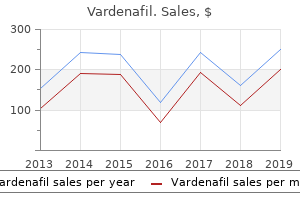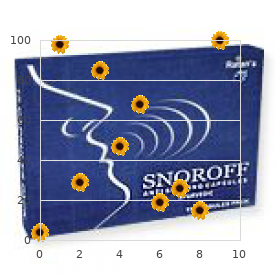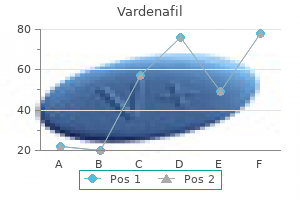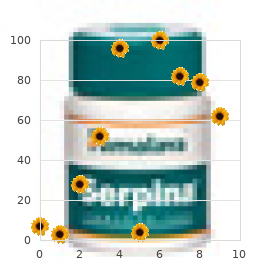Vardenafil
"Cheap 10 mg vardenafil with mastercard, erectile dysfunction doctors northern va".
By: Z. Marik, M.A., M.D.
Clinical Director, Philadelphia College of Osteopathic Medicine
In this regard impotence effect on relationship discount vardenafil 10 mg otc, the Committee hopes to erectile dysfunction causes stress order vardenafil 20 mg visa facilitate the evolution of data in this area by outlining modern requirements of scientific thought treatment of erectile dysfunction in unani medicine purchase vardenafil 20mg on line. In this way, the following taxonomy is designed to not be limiting or prescriptive but to present choices reflecting the diversity of present approaches and attitudes to the problem of spinal pain. The subsequent section beneath incorporates definitions of radicular pain and radiculopathy. In some cases each types of pain might stem from the one lesion and a single analysis may be formulated. It is, nevertheless, illegitimate to diagnose or classify any type of spinal pain as radicular pain or in phrases relating to radicular pain. Radicular pain in isolation is strictly a pain downside of the affected limb or body wall phase. When related to spinal pain, the spinal pain warrants an impartial classification to which the classification of the radicular pain might then be appended. As with radicular pain, the spinal pain ought to be categorised independently, supplemented if required by a classification of the radiculopathy. Both the spinal pain and the referred pain are brought on by the identical lesion (unless one believes the patient is suffering from two impartial pain issues), and identifying the situation or extent of any referred pain has little bearing on formulating a analysis. Consequently, in this taxonomy spinal pain issues are categorised based on their location but without deference to the presence or distribution of any referred pain. In compiling a taxonomy based mostly on anatomical and pathological axes, the Committee has endeavored to present a workable system of diagnostic criteria which can help to order the primary phenomena. The complete evaluation of a patient requires consideration beyond the anatomical analysis to think about the psychological, social, and vocational context and penalties of pain and their significance. Foraminal stenosis because of vertical subluxation of the intervertebral joint, osteophytes stemming from the zygapophysial joint or intervertebral disk, buckling of the ligamentum flavum, or a combination of any of the above. Foraminal stenosis because of miscellaneous problems of the zygapophysial joint similar to articular factures, slipped epiphysis, ganglion, joint effusion, and synovitis. Prolapsed intervertebral disk material that elicits an inflammatory reaction in the vertebral canal that secondarily produces irritation of adjacent neural parts. Radiculitis brought on by inflammatory exudates leaking from an intervertebral disk in the absence of frank prolapse. Radiculitis brought on by viral infection or postviral irritation of a dorsal root ganglion. Diagnosis: the analysis may be ascribed on scientific grounds alone if the appropriate scientific features are current. Where potential the segmental stage of the affected spinal nerve ought to be specified. The affected nerve but not the causative lesion may be specified if in the presence of the appropriate scientific features, a selective spinal nerve block abolishes the pain. Radicular pain might occur alone, in the absence of spinal pain, whereupon it ought to be categorised as limb pain or trunk pain based on its perceived distribution. Clinical Features: the pain is lancinating in high quality and travels alongside a narrow band. It could also be episodic, recurrent, or paroxysmal based on the causative lesion or any superimposed aggravating factors. Clinical Features: Subjective sensations of numbness and weakness, confirmed objectively by neurological examination and/or by electrodiagnostic means, occurring in the distribution of a spinal nerve. Radiculopathy might occur in isolation or in affiliation with radicular pain, referred pain, or spinal pain. Paresthesias in a dermatomal distribution may be brought on by ischemia of a spinal nerve or its roots, and could also be regarded as a function of incipient conduction block and due to this fact a function of radiculopathy. Pathology: Any lesion that causes conduction block in axons of a spinal nerve or its roots both directly by mechanical compression of the axons or indirectly by compromising their blood supply and diet. Foraminal stenosis because of vertical subluxation of the intervertebral joint, osteophytes stemming from the zygapophysial joint or intervertebral disk, buckling of the ligamentum flavum, or a combination of any of these. Prolapsed intervertebral disk performing mechanically as an area-occupying lesion that compromises axons. The two situations might nonetheless coexist and could also be brought on by the identical lesion; or radiculopathy might comply with radicular pain in the midst of a disease course of.

Diseases
- IgA deficiency
- Blastomycosis
- Distal myopathy Markesbery Griggs type
- Saccharopinuria
- Pai Levkoff syndrome
- Duchenne muscular dystrophy
- Apraxia, Ideomotor
- Cerebral palsy
- Protoporphyria, erythropoietic
- Gollop syndrome

Two age peaks are found impotent rage man vardenafil 10mg online, between 15 and 24 years of age causes to erectile dysfunction purchase vardenafil 20 mg on-line, wherein motorcar accidents are the most typical trigger erectile dysfunction shake generic vardenafil 10mg on line, and over the age of 64 years, wherein falls are most common. Males are more generally affected than females at all ages, and alcohol Routine measures embrace proper vitamin (utilizing, if needed, nasogastric tube feedings or percutaneous p 07. This chapter will talk about the medical features and treatment of the various features of traumatic brain harm, the etiology of these medical features, and the differential analysis between traumatic brain harm and concussion. The acute section, from a neuropsychiatric perspective, is usually dominated by a delirium; as the confusion clears, sufferers steadily enter into the continual section, which in flip may be characterized by numerous sequelae, together with cognitive deficits which will, at instances, be severe enough to constitute a dementia. This delirium, in addition to such characteristic signs as confusion, disorientation, and decreased short-time period reminiscence, is also usually marked by hallucinations, delusions, and, particularly, agitation, which is seen within the majority of cases (Rao and Lyketsos 2000; van der Naalt et al. It have to be borne in mind that although the delirium in such cases is generally as a result of the intracranial injuries directly brought on by the trauma, that other factors, as discussed in Section 5. Toxicity from such medications as opioids, baclofen, anticholinergics, metoclopramide, and even amantadine have to be thought of, together with metabolic factors, corresponding to hyponatremia, hypoglycemia, hypomagnesemia, and systemic results of infections, corresponding to pneumonia. Consideration may be given to the results of global cerebral ischemia secondary to severe hypotension and, in those with fractures of long bones, to the fat embolism syndrome. In comatose sufferers, intracranial strain monitoring is usually indicated, and treatment with intravenous sedation, mannitol, and other brokers may be required to cut back strain. Treatment of delirium, in all cases, involves easy environmental measures designed to cut back confusion. These embrace, whenever possible, having the patient in a quiet room, with a window. Sleep is important and consequently the room must be darkened and really quiet at evening, and all non-emergency procedures. In cases where these environmental measures are ineffective, pharmacologic treatment may be thought of with both an antipsychotic or, in certain emergent cases, lorazepam. Antipsychotics are indicated for treatment of hallucinations or delusions, and are also effective for agitation. A secondgeneration agent, corresponding to risperidone, is usually used, and, in follow quetiapine and olanzapine are also utilized. The first-generation agent haloperidol is also usually used, with preliminary doses of 25 mg. Repeat doses, in approximately comparable milligram amounts, could then be given every hour or so till the patient is calm, limiting aspect-results happen, or a most dose is reached: tough pointers for dose maxima are 5 mg for risperidone, a hundred and fifty mg for quetiapine, 20 mg for olanzapine, and 20 mg for haloperidol. In cases when the patient responds satisfactorily, a daily daily dose is ordered for the subsequent day (with the entire daily dose approximately equal to the entire required initially), divided into two or three doses. Provision is also made for additional as-wanted doses, with the entire daily dose being adjusted in accordance with the amount wanted in p. The eventual upkeep dose is then continued till the patient has been secure for a big period of time, at which point it may be steadily tapered. Once sufferers have been stabilized, general rehabilitation efforts may be began, together with bodily, speech, and occupational therapy. Eventually, most sufferers are transferred to a specialised rehabilitation facility, where these general efforts are continued. The Glasgow Coma Scale (Teasdale and Jennett 1974) is designed for evaluating sufferers within the acute section, and involves assessing three medical features: eye opening, motor response, and verbal response, with, as famous in Table 7. Patients with complete scores of 8 are stated to have a severe harm, those with scores from 9 to 12, a average harm, and people with scores of from thirteen to 15, a gentle harm. Post-traumatic seizures could happen in the course of the acute section, and these are discussed additional, beneath. Chronic section As the delirium steadily clears, almost all sufferers shall be left with one or more continual sequelae (Rao and Lyketos 2000), and these are discussed beneath, beginning with cognitive deficits, which are almost universal. In some cases these may be quite mild and never terribly limiting; nonetheless, in others they quantity to a transparent, and disabling, dementia. Most sufferers present enchancment over the primary 6 months, with some additional, but not as spectacular, gains over the subsequent 6 months: nonetheless, after 12 months, little additional spontaneous restoration may be expected. Pharmacologic treatment could embrace donepezil, amantadine, bromocriptine, or methylphenidate. Amantadine, in doses of a hundred mg within the morning and a hundred mg within the early afternoon, could likewise improve cognitive performance (Meythaler et al.

Diseases
- Neuritis with brachial predilection
- Chromosome 17, deletion 17q23 q24
- Tuberculous meningitis
- Aqueductal stenosis
- Glucocorticoid sensitive hypertension
- Usher syndrome, type 1C
- Pulmonary artery familial dilatation
- Acrocephaly
- Humero spinal dysostosis congenital heart disease
- Thiemann epiphyseal disease

Treatment should subsequently be directed towards the causal disorder erectile dysfunction pump on nhs generic 20 mg vardenafil free shipping, which can be either endometriosis or sequelae of acute pelvic inflammatory disease or of a pelvioperitonitis erectile dysfunction kit purchase cheap vardenafil on line, or a tuberculous salpingitis erectile dysfunction statistics uk buy vardenafil online pills. If the affected person complains of pain, reposition of the uterus might be tried and a pessary inserted. If the retroversion is fixed, treatment should be directed towards the causal situation and a suspension operation must be carried out solely when the retroversion itself is probably the cause of the criticism, as in some circumstances of dyspareunia, or when there are different causes for surgical intervention. The symptomatology of uterine retroversion and, specifically, pain in uterine retroversion (Dutch), Verhand. If the results of this examination is suitable with a useful cyst, it is recommended to treat it conservatively via oral contraceptives. There is a good likelihood that the cyst and the pain will disappear, whereas surgical exploration with wedge resection of the ovary is Page one hundred seventy likely to be adopted by a recurrence of the cyst and of the painful episode. Main Features: when a bilateral oophorectomy has been carried out in conditions that make it difficult to make certain that all ovarian tissue is removed. Diagnostic Criteria: an ovarian remnant might be suspected when the affected person presents proof of estrogen secretion that persists after a brief course of corticoids prescribed to suppress adrenal androstenedione secretion and its peripheral conversion to estrone. It has turn into clear that formerly many persistent painful conditions have erroneously been categorized under the above heading. Associated Symptoms an important symptom is decrease stomach pain and, much less frequently, low again pain. The decrease stomach pain could also be felt either in the whole decrease stomach or in each iliac fossae, or in a single fossa solely. The low again pain could also be felt over the whole width of the sacrogluteal zone or over part of this zone. The pain is normally extra severe for a number of days earlier than menstruation, and its depth decreases on the primary or second day of the period. Pathology Besides decrease stomach pain with or without sacrogluteal pain and the frequent criticism of deep dyspareunia, many sufferers have a number of complaints including one or more that are normally thought-about useful; these sufferers may subsequently be called polysymptomatic. Most oligosymptomatic sufferers complain merely of spontaneous pelvic pain and deep dyspareunia. During the final many years various conditions have been suspected as possible causes. It has been thought that in a percentage of circumstances the syndrome is because of traumatic laceration of a sacrouterine ligament or of a posterior leaf of 1 or each broad ligaments. There is good indirect proof that circulatory elements may give rise to persistent or intermittent decrease stomach pain. Main Features Chronic pelvic pain without obvious pathology is the name given recently to a syndrome that has been recognized and described for greater than a century under many different names, a few of them being: parametropathia spastica, pelvic congestion and fibrosis, pelipathia vegetativa, and pelvic sympathetic syndrome. However, the morphological or useful foundation of this tenderness remains to be elucidated. All those that studied the psychological characteristics of those sufferers found particular psychopathological anomalies or stress conditions in most, although not all, of the sufferers examined. At one finish, there are sufferers with very little peripheral noxious stimulation whose complaints will, to a large extent, have a psychological clarification. The different excessive is made up of persons with somewhat intense peripheral noxious stimulation: either pelvic circulatory disturbances or tenderness of the posterior parametrium and, much less often, uterine cramps or a real tear in a sacro-uterine ligament, and little or no psychological factor. In between these extremes there are apparently a number of combined circumstances with much less pronounced peripheral noxious stimulation and one or more of the psycho-physiological mechanisms that will induce complaints and care-in search of habits. Some sufferers have been helped with cyclic estroprogestogens; others have had hypo-estrogenic amenorrhea induced by continuous administration of oral progestogens. Main Features the pain can occur immediately after the operation but not sometimes occurs after months or years. The pain is burning or lancinating and radiates to the realm equipped by the sensory nerve. For the iliohypogastric nerve the pain radiates to the midline above the pubis but in addition laterally to the hip region.
